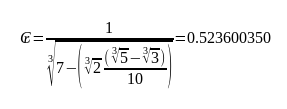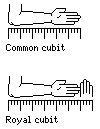Okay, REALLY last one for tonight. Found an approximation for the cubit using square roots. Not very good, in fact worst so far.
Formula is
Comparison table is now:
| Method | Value | Difference from π/6 | Abs difference |
|---|---|---|---|
| π/6 | 0.52359877559830 | 0.00000000000000 | 0.00000000000000 |
| φ²/5 | 0.52360679774998 | 0.00000802215168 | 0.00000802215168 |
| Ave Year | 0.52360779708785 | 0.00000902148956 | 0.00000902148956 |
| π – φ² | 0.52355866483991 | -0.00004011075839 | 0.00004011075839 |
| 10²/φ²π²ⅇ² | 0.52376444099003 | 0.00016566539172 | 0.00016566539172 |
| cube roots | 0.52360035017194 | 0.00000157457365 | 0.00000157457365 |
| square roots | 0.52340373684796 | 0.00019503875033 | 0.00019503875033 |





